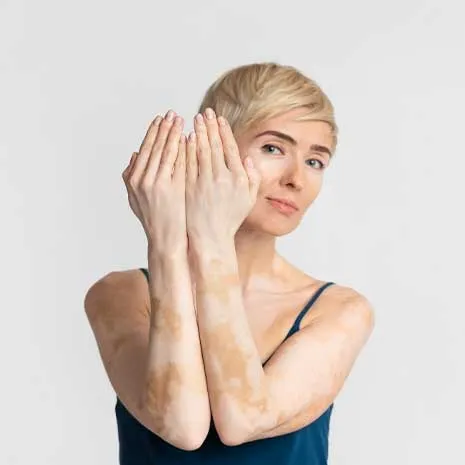Summer Precautions for People with Vitiligo

Summer Precautions for People with Vitiligo
- 19 July 2025
- 234

Vitiligo is an autoimmune skin disorder characterized by the destruction of melanocytes, leading to well-defined depigmented patches on the skin. Although the condition is not life-threatening or contagious, it presents significant dermatological and psychosocial challenges—especially during the summer months when sun exposure, heat, and outdoor activities increase dramatically.
Due to the lack of melanin, vitiliginous skin becomes highly vulnerable to ultraviolet (UV) radiation, trauma, and environmental stressors. This comprehensive guide outlines the key precautions vitiligo patients should take during the summer season, covering sun protection, skincare, nutrition, swimming, emotional well-being, and treatment considerations.
The Sun and Vitiligo: A Complex Relationship
Melanin plays a crucial role in protecting the skin from UV damage. In vitiligo, the absence of this pigment makes affected areas extremely photosensitive.
Risks of sun exposure include:
- Severe sunburns on depigmented areas due to absence of natural photoprotection
- Heightened contrast between tanned healthy skin and white patches, making vitiligo more noticeable
- New lesion formation via the Koebner phenomenon (lesions arising after trauma or sunburn)
Recommended sun protection:
- Apply broad-spectrum SPF 50+ sunscreen at least every 2–3 hours
- Focus on exposed areas like the face, neck, arms, and hands
- Avoid direct sunlight between 10:00 AM and 4:00 PM, when UV rays are strongest
- Use physical barriers such as umbrellas, hats, and sunglasses
Outdoor Activities and Skin Trauma
Summer invites hiking, sports, and travel—all of which increase the risk of skin friction, cuts, or trauma, triggering or worsening vitiligo lesions through Koebnerization.
Protective strategies:
- Avoid activities that cause repetitive rubbing or pressure on the skin
- Use protective gear (e.g., knee or elbow pads) if engaging in physical sports
- Wear gloves when gardening or hiking to reduce hand friction
- After sun exposure or physical activity, shower and apply moisturizers immediately
Choosing the Right Clothing for Protection and Comfort
Sun-safe clothing plays a vital role in vitiligo management during the summer. The goal is to minimize UV exposure while keeping the skin cool and dry.
Ideal clothing options:
- UPF-rated garments (Ultraviolet Protection Factor 50+)
- Loose-fitting, light-colored, breathable fabrics like cotton or bamboo
- Wide-brimmed hats and UV-blocking sunglasses for facial protection
- Long-sleeved shirts and full-length pants when outdoors for extended periods
Swimming: Sea and Pool Considerations
Swimming is not contraindicated for vitiligo patients, but the effects of saltwater, chlorine, and moisture loss need to be addressed carefully.
Seawater:
- Generally safe, but can dry the skin
- Rinse off thoroughly with fresh water after swimming
- Apply emollients or moisturizers post-swim
Chlorinated pools:
- Chlorine can irritate sensitive skin and exacerbate dryness
- Limit exposure time and rinse immediately afterward
- Apply a protective barrier cream before swimming if needed
- Avoid public pools if skin is already inflamed or irritated
Treatment Adjustments in Summer
Many patients undergo topical or phototherapy treatments, which may require seasonal adjustments to avoid overexposure or side effects.
Key points:
- Patients undergoing narrowband UVB therapy must avoid additional unprotected sun exposure
- Topical corticosteroids and calcineurin inhibitors (like tacrolimus) may increase photosensitivity
- Discuss any treatment breaks or dose adjustments with your dermatologist before the summer starts
Emotional and Social Impact During Summer
Wearing shorter clothes during summer may make vitiligo more visible, triggering emotional responses such as anxiety, embarrassment, or social withdrawal.
Coping strategies:
- Connect with support groups (online or in-person) for encouragement
- Follow vitiligo advocates and positive representation on social media
- Consider psychological counseling if anxiety or depression interferes with daily life
- Practice body positivity and self-acceptance—many celebrities and models have embraced their vitiligo
Nutrition and Hydration: Internal Support for the Skin
Proper hydration and antioxidant intake are crucial for skin health, especially in hot weather.
Recommended nutrients:
- Beta-carotene (carrots, pumpkin, apricots) to support skin regeneration
- Vitamin C (citrus fruits, red bell peppers, strawberries) for collagen production
- Zinc, copper, and B12 to aid immune function and pigmentation
- Drink at least 2–2.5 liters of water per day to keep skin hydrated
Frequently Asked Questions
Yes, but only with proper sun protection. Use SPF 50+ sunscreen, avoid peak UV hours, and wear protective clothing.
Generally yes. However, be cautious of chlorine and saltwater. Always rinse and moisturize afterward.
Not necessarily. But consult your doctor to adjust phototherapy or topical regimens to avoid excessive UV exposure.
Because surrounding healthy skin tans and the contrast with depigmented areas becomes more pronounced.
You’re not alone. Psychological counseling, support groups, and body-positive resources can help build self-confidence.
